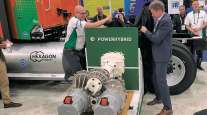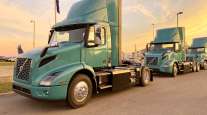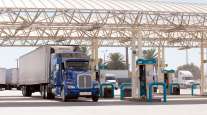California May Tear Down Major Bridges to Build Bigger Ones for Oversized Trucks

Flush with new gas tax funds, state officials are exploring what could be the biggest Sacramento freeway redo in modern times – tearing down and replacing the twin freeway bridges that carry Interstate 5 over the American River.
Caltrans says the half-mile spans just north of downtown are among 45 pinch-points the agency has identified on three major freight corridors – I-5, I-580, I-10/60 – that force oversized trucks onto sometimes long and costly detours.
In some cases, overpasses are too low. A notorious one on I-80 in Berkeley less than 5 miles from the Oakland port is only 14 feet, 9 inches tall, more than a foot lower than the 16-foot modern federal standard for existing bridges. Federal standards for new bridges are 16 feet, 6 inches.
In other cases, 1960s-era bridges are no longer considered strong enough to carry extra-heavy commercial vehicles that traverse state highways daily. In Sacramento, officials have identified three “no-go” zones for big trucks, all within a few miles of each other on I-5 near downtown.
RELATED: Spend gas tax money ASAP, new Caltrans leader says of directive from California Gov. Jerry Brown
The most notable are the dual spans over the American River and Discovery Park. The other two are bridges over land, one that carries I-5 traffic over the downtown railyard and another over Broadway just south of downtown, both of them congested daily commute routes for thousands of Sacramentans.
Some heavy trucks, typically more than 80,000 pounds, will take a 51-mile detour by exiting I-5 at Florin Road or farther south. From there, they work their way over to Sunrise Boulevard, then use Greenback Lane and Elkhorn Boulevard and finally loop back to Highway 99 to rejoin I-5 near the airport.
The state already has begun eliminating pinch-points on major freeways locally. Caltrans spent $36 million to raise nine freeway overpasses on I-80 between Sacramento and the Nevada state line, finishing that project in 2016. The work allowed extra-tall trucks to avoid an extended detour that took some of them up Auburn-Folsom Road, then onto Highway 49 to Grass Valley and on Highway 20 to get back to I-80.
But officials say they lacked the funds to do more extensive fixes until the Brown administration pushed through the gas tax and vehicle fee hike last year, estimated to generate $5.4 billion annually.
RELATED: California could see the return of $4 gasoline by May
Some taxpayer groups have branded the gas tax a waste and are trying to put a measure on the November ballot asking voters to repeal it. But Brown administration officials say the new revenues are overdue and that it is smart to use a chunk of the money to speed goods movement.
“The freight industry in California is a big part of the economy,” said California Transportation Agency Secretary Brian Annis. “We have major ports and those ports have competitors in other states. Investing in this type of infrastructure ... gets goods efficiently to market.”
Focusing on the three main freight freeways that connect to coastal ports will give the state more bang for the buck, Annis said. “It is efficient for freight, but good for communities too, because you are keeping the trucks on those primary freight corridors.”
But the costs of the potential projects are high, and the number of vehicles involved is low compared to the average daily traffic using those freeways.
The vehicles in question are the biggest of commercial trucks, larger than the typical 80,000-pound supermarket or Costco delivery trucks. They typically require a special permit in California and include 9-axle or larger trucks carrying cranes and other large construction equipment; parts of prefabricated buildings; farm equipment; or electric transformers. Sometimes they travel at slow speeds at night with CHP escorts.
Caltrans does not have precise data on how many oversize and overweight trucks travel through California. At The Bee’s request, Caltrans officials last week estimated that as many as 170 trucks a day have to make detours around Sacramento because they are either too large or too heavy to cross the downtown I-5 bridges.
Statewide, Caltrans officials say they issued about 146,000 permits for single trips to oversized vehicles in 2017. That’s 400 trips a day. Other trucking companies got 16,300 annual permits last year, allowing their trucks to make multiple trips. The state does not have a count of how many trips – or detours – those trucks make.
The physical condition of the I-5 bridges over the American River add to the uncertainty. The state recently downgraded their load carrying capacities, and no truck heavier than 80,000 pounds – about the size of a large supermarket delivery truck – is allowed on them.
But the bridges still hold a Caltrans “good health” rating, which makes them sturdy enough to handle all but a fraction of traffic that comes through Sacramento.
If Caltrans decides to tear down and replace all three I-5 sections, the tab could hit $1.5 billion. That could include carpool lanes and a separate area for bicycles and pedestrians. But work could span more than five years and would involve extensive lane closures – and possibly full freeway closures at times.
“The local community may have a negative reaction,” a Caltrans project risk analysis says.
That section of Interstate 5 has become congested in recent years, and commuters already find themselves jockeying for position with big rig trucks, said Marilyn Bryant, director of the Sacramento Transportation Management Association, a group of drivers and businesses focused on improving commutes.
“We have a lot of commuters come down from Natomas every day, and trucks are already something drivers worry about on that stretch,” Bryant said. “It creates problems. They are so large and everyone is trying to maneuver around them.”
The project would require a formal environmental review process, during which the state will solicit public comment and concerns.
If engineers determine they can keep the existing spans but strengthen them to hold bigger trucks, the retrofit cost would be considerably less, about $400 million.
Crews have been out on the bridge recently, boring holes to test its strength and help them decide in which direction they should go. Local project managers last week declined to say which way they might lean.
“We are at the ground floor in the engineering studies and analysis of what needs to be done,” Caltrans manager Jess Avila said. “It could be a year before engineers come up with a conclusion to strengthen or replace it.”
Distributed by Tribune Content Agency, LLC




